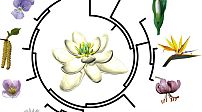The world’s first flower was bisexual and its petals were organised in concentric circles, a study has concluded.
Researchers believe all flowers evolved from this single ancestor, which lived about 140 million years ago during the dinosaur era.
Scientists made their conclusions after combining the largest dataset of floral traits ever assembled with models of flower evolution.
This allowed them to infer the appearance of the first flower (pictured, above).
Hervé Sauquet, the main author and co-ordinator of the study, said: “It is the first time we have shown that the ancestor of all flowers possessed both female (carpels) and male (stamens) parts, even if, for botanists, it shouldn’t constitute a surprise.”
Flowering plants (Angiospermae) first appeared around 140 million years ago and have enjoyed a spectacular diversification since.
There are now 300,000 different species, representing 90 percent of plants.
The study’s reconstruction of what the first flower looked like is not wildly different from what many flowers look like today.
In addition, as Sauquet alludes to, the fact it was bisexual is not earth-shattering either – many flowers today are too.
Patrick Monahan, writing for sciencemag.org, said one key surprise is the fact the first flowers were estimated to have their petals organised in concentric circles, rather than in spirals.
The study, published in Nature Communications, said in spite of the first flower’s similarities with existing ones, there is no living species that share its exact combination of characters.

All living flowers ultimately derive from a single ancestor (pictured in the centre) that lived about 140 million years ago. To find out what this ancestral flower may have looked like and trace back the evolution of flowers since then, the new study used the evolutionary tree (here simplified) that connects all living species of flowering plants. Credit: Hervé Sauquet & Jürg Schönenberger











